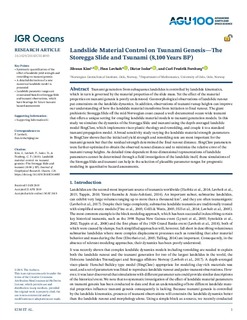| dc.contributor.author | Kim, Jihwan | |
| dc.contributor.author | Løvholt, Finn | |
| dc.contributor.author | Issler, Dieter | |
| dc.contributor.author | Forsberg, Carl Fredrik | |
| dc.date.accessioned | 2019-09-02T07:35:43Z | |
| dc.date.available | 2019-09-02T07:35:43Z | |
| dc.date.created | 2019-05-07T09:26:16Z | |
| dc.date.issued | 2019 | |
| dc.identifier.citation | Journal of Geophysical Research - Oceans. 2019, 124 (6), 3607-3627. | |
| dc.identifier.issn | 2169-9275 | |
| dc.identifier.uri | http://hdl.handle.net/11250/2611932 | |
| dc.description.abstract | Tsunami generation from sub‐aqueous landslides is controlled by landslide kinematics, which in turn is governed by the material properties of the slide mass. Yet, the effect of the material properties on tsunami‐genesis is poorly understood. Geomorphological observations of landslide run‐out put constraints on the landslide dynamics. In addition, observations of tsunami run‐up heights can improve our understanding of how the landslide material transforms from initiation to final run‐out. The giant prehistoric Storegga Slide off the mid‐Norwegian coast caused a well documented ocean‐wide tsunami that offers a unique setting for coupling landslide material models to tsunami generation models. In this study we simulate the dynamics of the Storegga Slide and tsunami using the depth‐averaged landslide model BingClaw, which implements visco‐plastic rheology and remolding, and couple it to a standard tsunami propagation model. A broad sensitivity study varying the landslide material strength parameters in BingClaw showed that the initial soil yield strength and remolding rate are most important for the tsunami‐genesis, but that the residual strength determined the final run‐out distance. BingClaw parameters were further optimized to obtain the observed run‐out distance and to minimize the relative error of the tsunami run‐up heights. As detailed time‐dependent three‐dimensional representations of landslide parameters cannot be determined field investigation of the landslide itself, these simulations of the Storegga Slide and tsunami can help in the selection of plausible parameter ranges for prognostic modeling in quantitative hazard assessments. | |
| dc.description.abstract | Landslide Material Control on Tsunami Genesis ‐ The Storegga Slide and Tsunami (8100 y BP) | |
| dc.language.iso | eng | |
| dc.title | Landslide Material Control on Tsunami Genesis ‐ The Storegga Slide and Tsunami (8100 y BP) | |
| dc.type | Peer reviewed | |
| dc.type | Journal article | |
| dc.description.version | publishedVersion | |
| dc.source.pagenumber | 3607-3627 | |
| dc.source.volume | 124 | |
| dc.source.journal | Journal of Geophysical Research - Oceans | |
| dc.source.issue | 6 | |
| dc.identifier.doi | 10.1029/2018JC014893 | |
| dc.identifier.cristin | 1695950 | |
| dc.relation.project | Norges forskningsråd: 231252 | |
| cristin.unitcode | 7452,4,2,0 | |
| cristin.unitcode | 7452,3,1,0 | |
| cristin.unitcode | 7452,4,3,0 | |
| cristin.unitname | Computational Geomechanics (CGM) | |
| cristin.unitname | Snø- og steinskred | |
| cristin.unitname | Offshore geoteknikk | |
| cristin.ispublished | true | |
| cristin.fulltext | original | |
| cristin.qualitycode | 2 | |
